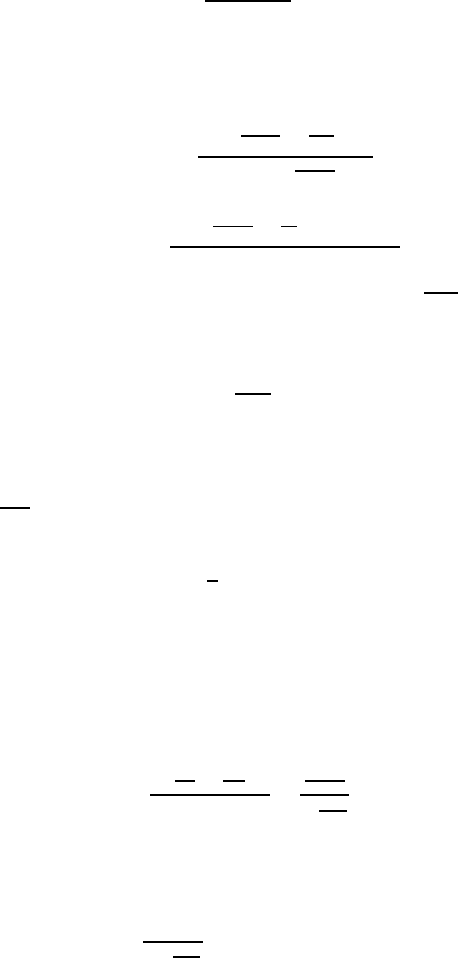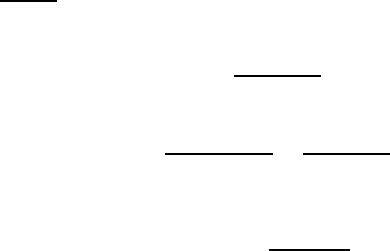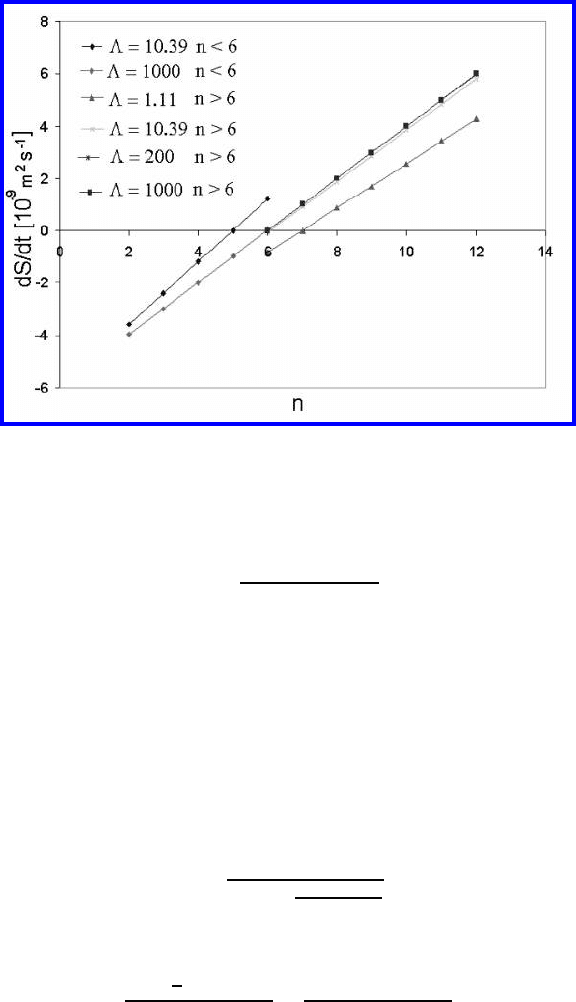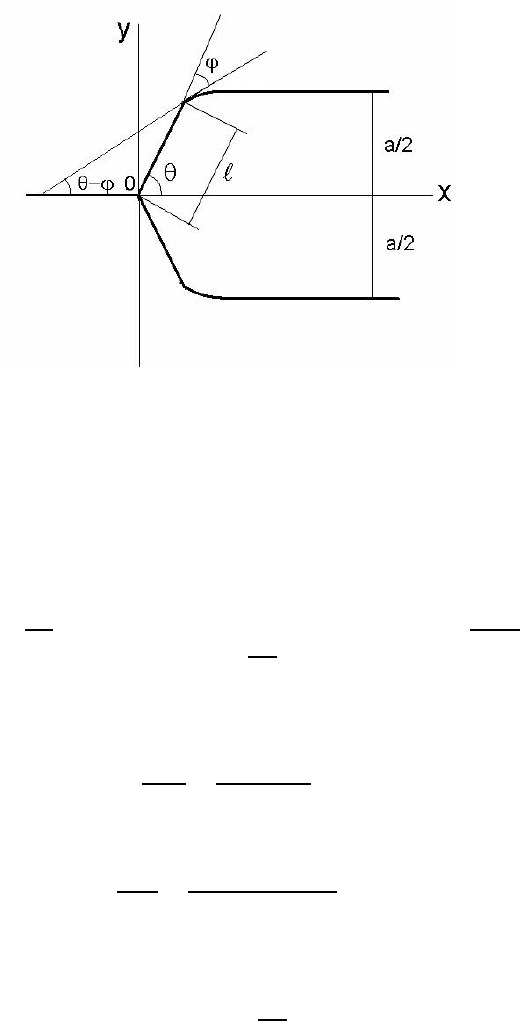Gottstein G., Shvindlerman L.S. Grain Boundary Migration in Metals: Thermodynamics, Kinetics, Applications
Подождите немного. Документ загружается.


628 8Solutions
If the particles are rather small then their motion should be controlled by
interface diffusion (see Sec. 3.5), and the particle mobility can be expressed
as
m
p
(r)=
δ
πr
4
D
s
Ω
kT
(8.168)
where δ is the effective thickness of the surface layer, δ
∼
=
10
−9
m, D
s
is
an interface diffusion coefficient (D
s
∼
=
10
−11
m
2
/s), Ω is an atomic volume
(Ω = 10
−5
m
3
/mol). Finally, the expression for the criterion λ
part,b
reads
λ
part,b
=
4δD
s
Ω
rkTc<D>m
b
(8.169)
Taking <D>for the initial grain microstructure equal to <D>
∼
=
3·10
−5
m,
we obtain
λ
part,b
∼
=
0.2 (8.170)
The results of the computer simulation of grain growth in Al at the same
values of the parameters [623] are expressed in the time dependency of the
mean grain size <D>. Basically the criterion λ is the ratio of the rate of
grain growth under the action of a drag factor and free grain growth. In other
words, we should find the ratio of
d<D>
dt
for the grain growth with the mobile
particles and in the case of a pure grain boundary. The results for different
<D>are given in Table 8.1. One can see that the agreement between the
evaluation given by Eq. (8.169) and the experiment is reasonable.
TABLE 8.1
Efficiency of Grain Growth Inhibition by Second-Phase Particles
<D> λ
part,b
λ
part,b
from Eq. (8.169) from computer simulation [623]
7 · 10
−5
m 0.1 0.36
5 · 10
−5
m 0.14 0.16
PROBLEM 3.11
Let us consider the grain growth inhibited by second-phase particles. If the
particles are rather small there are two ways of inhibiting grain growth: Zener
drag, where the interaction between particles and grain boundary reduces
the driving force of grain growth, and the joint motion of particles and grain
boundary.
For the sake of simplicity we consider the single size distribution. Using
relation (3.61) (see Chapter 3) the grain growth kinetics for Zener dragging
canbeexpressedas
d<D>
dt
= m
b
γ
<D>
−
3cγ
r
(8.171)
© 2010 by Taylor and Francis Group, LLC

8Solutions 629
where <D>is the mean grain diameter of the polycrystal.
The grain growth kinetics for the joint motion of grain boundary and par-
ticles is given by Eq. (3.71) (see Chapter 3)
V =
γm
p
(r
0
)
<D>n
0
(8.172)
n
0
is the number of the particles per unit area of the boundary. The criterion
λ, which determines the relative efficiency of these two ways of dragging (see
Chapter 6) can be constructed as
λ
Zener, part
=
m
b
γ
<D>
−
3cγ
r
0
n
0
m
p
(r
0
)
γ
<D>
(8.173)
or
λ
Zener, part
=
m
b
1
<D>
−
3c
r
0
n
0
<D>
m
p
(r
0
)
(8.174)
The number of particles per unit area of the boundary n
0
=
3c
2πr
2
.Forrather
small particles the dominant mechanism of the mass transfer is interfacial
diffusion; that is why the particle mobility is inversely proportional to r
4
(Chapter 3, Eq. (3.35))
m
p
=
m
p0
πr
4
0
(8.175)
The expression for λ
Zener, part
can be transformed into
λ
Zener, part
= M
r
2
0
− 3cr
0
<D>
(8.176)
where M =
m
b
m
p0
c.
Relation (8.176) has a minimum at
r
0
=
3
2
c<D> (8.177)
Such radius of second-phase particles in a single size distribution complies
with the maximal relative efficiency of Zener drag.
PROBLEM 3.12
1. The slope of the line H/k−lnA
0
can be determined by analytical geometry
— the straight line which passes through two points
T
c
=
H
i
k
−
H
j
k
lnA
0i
− lnA
0j
=
ΔH
ij
k
ln
A
0
i
A
0
j
(8.178)
where H
i
, H
j
, A
0i
, A
0j
are the activation enthalpies and the pre-exponential
factors of the two considered grain boundaries, respectively.
For grain boundaries I and II we arrive at
T
c
=
ΔH
ij
kln
A
0i
A
0j
= 672 K (399
◦
C) (8.179)
© 2010 by Taylor and Francis Group, LLC

630 8Solutions
for grain boundaries I and III the compensation temperature is equal to 681
K (408
◦
C) and for the pair II-III boundaries T
c
= 667 K (394
◦
C).
1. Let us now find the compensation temperature as the point of intersection
of two (or more) kinetic dependencies in coordinates ln
A
b
A
0
−
H
kT
,namely
A
1
x + B
1
y + C
1
=0
A
2
x + B
2
y + C
2
= 0 (8.180)
H
i
1
T
+lnA
bi
− lnA
0i
= 0 (8.181)
Solution by matrix algebra yields
1
T
c
=
-
-
-
-
B
1
C
1
B
2
C
2
-
-
-
-
-
-
-
-
A
1
B
1
A
2
B
2
-
-
-
-
, lnA
b
c
=
-
-
-
-
C
1
A
1
C
2
A
2
-
-
-
-
-
-
-
-
A
1
B
1
A
2
B
2
-
-
-
-
(8.182)
or for the pair GBI–GBIII we arrive at
1
T
c
=
-
-
-
-
1 −4.6
1 −9.2
-
-
-
-
-
-
-
-
1.62 · 10
4
1
1.92 · 10
4
1
-
-
-
-
, lnA
b
c
=
-
-
-
-
−4.61.62 · 10
4
−9.21.92 · 10
4
4
-
-
-
-
-
-
-
-
1.62 · 10
4
1
1.92 · 10
4
1
-
-
-
-
(8.183)
1
T
c
=
−9.2+4.6
1.62 · 10
4
− 1.93 · 10
4
=1.48 · 10
−3
K
−1
T
c
= 674 K (401
◦
C); A
bc
=4· 10
−9
m
2
/s.
For the grain boundaries II-III and I-II we get, respectively,
T
c
= 667 K(394
◦
C; A
bc
=2· 10
−9
m
2
/s
T
c
= 676 K(403
◦
C; A
bc
=3· 10
−9
m
2
/s
2. The condition that three grain boundaries intersect in one point is
-
-
-
-
-
-
A
1
B
1
C
1
A
2
B
2
C
2
A
3
B
3
C
3
-
-
-
-
-
-
= 0 (8.184)
or
A
1
B
2
C
3
− B
1
C
2
A
3
− C
1
A
2
B
3
− C
1
B
2
A
3
− A
1
C
2
B
3
− B
1
A
2
C
3
=0
(8.185)
The sum in Eq. (8.185) is equal to ∼ 592.
Eq. (8.185) gives an assessment of the deviation of the pair intersection
points from the virtual triple point. It is noteworthy that the magnitude of
every term in (8.185) is in the range of 10
5
. So the intersection points are very
© 2010 by Taylor and Francis Group, LLC

8Solutions 631
close to each other.
3. The mobilities of the grain boundaries at 320
◦
C are equal, respectively:
GBI : A
b
=1.3 · 10
−10
m
2
/s
GBII : A
b
=2.0 · 10
−11
m
2
/s
GBIII : A
b
=2.4 · 10
−7
m
2
/s
The mobilities of these grain boundaries at 520
◦
Care
GBI A
b
=1· 10
−7
m
2
/s
GBII A
b
=1.0 · 10
−6
m
2
/s
GBIII A
b
=2.4 · 10
−7
m
2
/s
At a temperature lower than T
c
the boundaries with low energy of activation
are most mobile, whereas at temperatures higher than T
c
grain boundaries
with a high energy of activation are the fastest ones.
PROBLEM 3.13
From Eq. (3.234) we arrive at
m = m
0
(1 − αV ) (8.186)
where m
0
is the grain boundary mobility without magnetic field α =
σ
c
2
.
From Eq. (8.186) we obtain the relation for the grain boundary mobility in
a magnetic field in the case that the driving force of grain boundary motion
is a capillary driving force
m = m
0
[1 − α (mγκ)] (8.187)
where κ is the curvature.
Then the kinetic equation for grain growth in a polycrystal in a magnetic
field reads
dR
dt
=
m
0
γ
1+
αm
0
γ
R
R
(8.188)
and the time dependency for the mean grain radius R can be expressed as
1
2
R
2
−−R
2
0
+ αm
0
γ (R − R
0
)=m
0
γt (8.189)
where R
0
is the mean grain radius at t = 0. (The mean grain size (twice the
radius R) and the radius of the curvature of the moving grain boundary are
not identical. Here we do not make a distinction between these parameters
since we are looking for a qualitative result.)
It should be stressed that, as describedinChapter3,thereareseveralcon-
tributions to the total drag force, some of which can be characterized by a
strong dependency of the mobility change on the grain boundary migration
rate. Eq. (8.186) represents the simplest one.
© 2010 by Taylor and Francis Group, LLC

632 8Solutions
PROBLEM 4.1
(a) The volume fraction c of the particles is equal to
c =
4
3
πr
3
N
∼
=
4 · 10
−3
Then the maximum pinning force
f
1
=
3cγ
r
=6· 10
5
J/m
3
(b)
c =
4
3
πr
3
N =5·10
−3
f
1
=
3cγ
r
=
3 · 10
−3
· 0.5
5 · 10
−9
=1.4 · 10
6
J/m
3
(8.190)
PROBLEM 4.2
(a) If a spherical particle with radius r intersects a triple line the total reduc-
tion of grain boundary energy and the line energy of the triple junction can
be expressed as
ΔG = γ
1 −
3
2
πr
2
− 2rγ
(8.191)
where γ
is the line tension of the triple junction.
Correspondingly, the maximum attraction force f
∗
is
f
∗
=3πrγ +2γ
(8.192)
The particles in contact with the triple junction are confined to a volume
π(2r)
2
4
.1m=πr
2
, i.e. the number of particles per 1m of triple junction length
is equal to
¯n = πr
2
· N =
3c
4r
(8.193)
Thus, the maximum pinning force f
∗
max
f
∗
max
=¯nf
∗
·
¯
L (8.194)
where
¯
L is the length of the triple junction per 1 m
2
of a grain boundary.
The number of a triple junctions N
tr
in a polycrystal per unit volume is
equal to [551]
N
tj
≈ 12n (8.195)
where n is the number of grains per unit volume.
Let us consider the grains as spheres with diameter <D>. Then the
© 2010 by Taylor and Francis Group, LLC

8Solutions 633
number of grains per unit volume is equal to
6
π<D>
3
and the total area of the
grain boundaries is
1
2
6
π<D>
3
· π<D>
2
=
3
<D>
(8.196)
The coefficient 1/2 is introduced due to the fact that one boundary belongs
to two grains.
Then N
tj
can be expressed as
N
tj
=12n =
72
π<D>
3
(8.197)
The total length of the triple junctions per unit volume can be evaluated as
¯
L
tj
∼
=
1
2
<D>N
tj
=
36
π<D>
2
(8.198)
The desired ratio of the length of the triple junctions to grain boundary area
¯
L reads
¯
L =
¯
L
tj
3/<D>
=
12
π<D>
(8.199)
Finally, the maximal pinning force by particles on triple junctions can be
expressed as
f
2
=
3c
4r
· f
∗
·
¯
L =
3c
4r
·
3πrγ +2γ
·
12
π<D>
∼
=
25
γc
<D>
+6·
γ
c
r<D>
(8.200)
P
2
∼
=
50 · 10
3
J/m
3
+25· 10
2
J/m
3
∼
=
5.3 · 10
4
J/m
3
(8.201)
As can be seen for the given parameters, the pinning force of the particles on
the triple junctions is at least an order of magnitude smaller than the pinning
force from the particles on the grain boundary. The general pinning force is
equal to the sum of these pinning forces. The force f
2
is the pinning force
when the particles are located exactly on the triple line.
(b) The pinning force is equal to (see Eq. (8.201) in the previous problem):
f
2
=25
γc
<D>
+6
γ
c
r<D>
c =
4
3
πr
4
N
∼
=
5 · 10
−3
f
2
∼
=
9 · 10
5
J/m
3
© 2010 by Taylor and Francis Group, LLC

634 8Solutions
PROBLEM 4.3
(a) If a spherical particle with radius r is located at a quadruple point the
total reduction of the grain boundary energy can be expressed as
ΔG = γ
1 − 2πr
2
(8.202)
Since nothing is known about the energy of a quadruple junction we assume
that we can neglect the effect of this parameter on the energetics of the system.
From (8.202) we obtain the maximum attraction force f
∗
3
f
∗
3
=4πrγ (8.203)
If we assume that a quadruple junction can be occupied by only one particle,
then the maximum pinning force f
3
will be equal to
f
3
=4πrγc ·
¯
N
quad
(8.204)
where
¯
N
quad
is the number of quadruple junctions per unit grain boundary
area.
The number of quadruple junctions in a polycrystal with n grains per unit
volume is equal to [551]
N
quad
∼
=
6n (8.205)
Since n =
6
π<D>
3
,where<D>is the diameter and 3/<D>is the total
grain boundary area per unit volume
N
quad
=
36
π<D>
3
(8.206)
and
¯
N
quad
=
36 <D>
π<D>
3
·3
=
12
π<D>
2
(8.207)
Then for the maximum pinning force f
3
we arrive at
f
3
=4πrγc
¯
N =
64πr
4
γN
<D>
2
(8.208)
Substituting the parameters given in the problem we come to
f
3
∼
=
10
3
J/m
3
(8.209)
Note that the force f
3
depends very strongly on the size of the second-phase
particles.
(b) Substituting the parameters of the problem into Eq. (8.208) yields
f
3
=10
7
J/m
3
© 2010 by Taylor and Francis Group, LLC

8Solutions 635
PROBLEM 4.4
The total grain boundary area of a sample with the mean grain size <D>
is equal to
S =
3
<D>
(8.210)
On the other hand, the rate of grain boundary motion is equal to
˙
R =
mγ
R
(8.211)
where R is the radius of the curvature of the moving boundary; R ∼<D>.
Then
dS
dt
= −
3
<D>
2
d<D>
dt
∼−
3mγ
<D>
3
∼−
1
9
mγS
3
(8.212)
PROBLEM 4.5
The rate of grain area change is given by the Von Neumann-Mullins relation
dS
dt
= −A
b
[2π − n(π − 2θ)] (8.213)
As shown in Chapter 4 for a system with triple junctions of finite mobility
the angle θ is a function of the dimensionless parameter Λ (Λ =
m
tj
a
m
b
). The
equilibrium value θ = π/3 is obtained for Λ →∞
dS
dt
=
π
3
m
b
γ(n − 6) (8.214)
To find the dependence of the grain area change rate for Λ = ∞ aconsidera-
tion of the relation (8.213) in the vicinity of “equilibrium” (θ = π/3) can be
invoked (Eqs. (4.82) and (4.85)). The diagram of
dS
dt
for different Λ is given
in Fig. 8.10.
For Λ
∼
=
10 and grains with n<6 the topological class which meets the con-
dition
dS
dt
= 0 is equal to 5 instead of 6 as for Λ →∞. A similar phenomenon
can be observed qualitatively for grains with n>6, however, quantitatively
it manifests itself as less pronounced. For example, the line
dS
dt
(n)forn>6
intersects the axis n in the point n =7atΛ=1.11. For rather large Λ both
the lines — for n<6andn>6 — merge, as can be seen for Λ = 10
3
.
PROBLEM 4.6
As shown in Chapter 3 for the steady-state motion of a grain boundary half-
loop the following relations for the grain boundary velocity and the velocity
of the facet hold:
V =
m
b
γ(θ − ϕ)
a/2 − sin θ
(8.215)
© 2010 by Taylor and Francis Group, LLC

636 8Solutions
FIGURE 8.10
Diagram “grain area change vs. topological class” for different values of the
criterion Λ.
V =
m
f
γ sin ϕ sin θ
(8.216)
In the case that the grain boundary system includes a triple junction
(Fig. 8.11) the velocity of the triple junction can be expressed as
V = m
tj
(2γ cos ϕ cos θ − γ) (8.217)
It is stressed that for a steady-state motion the faceted and the curved
segments of the half-loop along with the triple junction have to move with the
same velocity.
Combining Eqs. (8.215) and (8.216) yields the length of a moving facet
=
a/2
sin θ +
m
b
(θ−ϕ)
m
f
sinϕ·sinθ
(8.218)
From Eqs. (8.215) and (8.217) we arrive at
m
tj
a
2
− sin θ
m
b
=
θ − ϕ
2cosϕ cos θ −1
(8.219)
One can see that the left hand-side of Eq. (8.219) constitutes the criterion
Λ for a grain boundary system with triple junction and a facet. However,
© 2010 by Taylor and Francis Group, LLC

8Solutions 637
FIGURE 8.11
Grain boundary system with facets and triple junction.
contrary to the criterion Λ considered in Chapter 4, there is one distinctive
property of the criterion analyzed here. Namely, since the right-hand side of
Eq. (8.219) is a constant value, by definition, the changes in grain boundary
and triple junction mobility have to be compensated by a variation of the
facet length .
If the ratio
m
tj
m
b
increases tends to its maximal value =
a
2sinθ
.By
contrast, when the decrease of the ratio
m
tj
m
b
causes the disappearance of the
facet = 0, the grain boundary system transforms into the well-known grain
boundary configuration with a triple junction (Fig. 4.2). Indeed, in this case
ϕ = 0 and Eq. (8.219) converts to
m
tj
a
m
b
=
2θ
2cosθ − 1
(8.220)
Combining Eqs. (8.216) and (8.217) we arrive at
m
tj
m
f
=
sin ϕ sin θ
2cosϕ cos θ −1
(8.221)
Again, as discussed above, the left-hand side of relation (8.221) is a criterion
Λ for a grain boundary half-loop with facet and triple junction; this criterion
is expressed in terms of triple junction and facet mobility. Contrary to the
criterion (8.219), an increase in the ratio
m
tj
m
f
in (8.221) leads to a reduction
of . One can see that at = 0 the right-hand side tends to zero as well: at
=0theangleϕ =0.
© 2010 by Taylor and Francis Group, LLC
